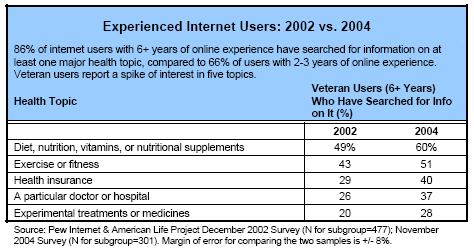The Web is increasingly seen as an information resource.
Previous research by the Pew Internet & American Life Project suggests that as people gain more experience using the internet, their use becomes more serious.4 As a majority of the population moved online, expectations grew and an overwhelming number of internet users began to expect to find the health information they need online.5
There are many reasons why internet users might now be more likely to search for certain types of health information. Many health-related Web sites are supplying more content and that might be driving users toward certain topics. Government agencies’ call for obesity awareness and public education about nutrition may be increasing public awareness and prompting more traffic. The pharmaceutical industry’s marketing campaigns may be paying off in increased interest in their products. More Americans may be looking for good deals on health insurance or checking up on their hospital’s quality ratings online. The clamor for experimental treatments may be growing as internet users become aware of the possibilities available to them.
Speed of access and years of online experience are among the key trends that may influence online health searching.
Two ongoing trends in the internet population may reinforce some users’ greater tendency to seek out certain health information online. There are now many more internet users with high-speed or broadband access at home. Additionally, there are many more internet users with six or more years of online experience.
In December 2002, 25% of users went online from home using a broadband connection and 72% used a dial-up connection. As of November 2004, 49% of internet users enjoy high-speed access to the internet at home, and 48% of internet users remain on dial-up connections at home. In all, 63% of internet users now have a fast connection at home or at work and 37% of internet users have only dial-up access.
In previous research, the Pew Internet & American Life Project has found that broadband access changes the way internet users behave online.6 Broadband users are likely to take part in seven online activities on a typical day, while a dial-up user takes part in three. Broadband users are more likely than dial-up users to turn first to the internet when they have a health question, rather than turning first to a doctor.7 As high-speed connections proliferate, more internet users take advantage of the “always on” connection to take care of personal business, whether that includes banking,8 communicating with colleagues and loved ones, or finding health-related information.

In December 2002, 36% of internet users had been online for six years or more. As of November 2004, 55% of internet users had been online for that long. The Pew Internet Project has found that the longer someone has had access, the more likely they are to view the internet as a utility and to turn to it for all sorts of serious matters.9 Sixty-six percent of internet users with just two or three years of online experience have looked online for information about at least one health topic, compared to 86% of internet users with six or more years of experience.
Since internet newcomers are scarce (just one in five users got access within the last three years), it is more illuminating to compare veteran users’ change over time than to compare newbies to veterans.

These “power users” may now turn to the internet not only when they have a pressing concern, but when they have an every-day sort of health question such as how to get fit, how to eat well, or to check if something is covered by their health insurance.




